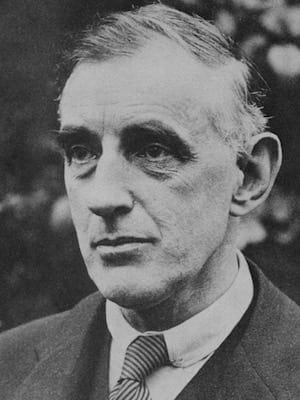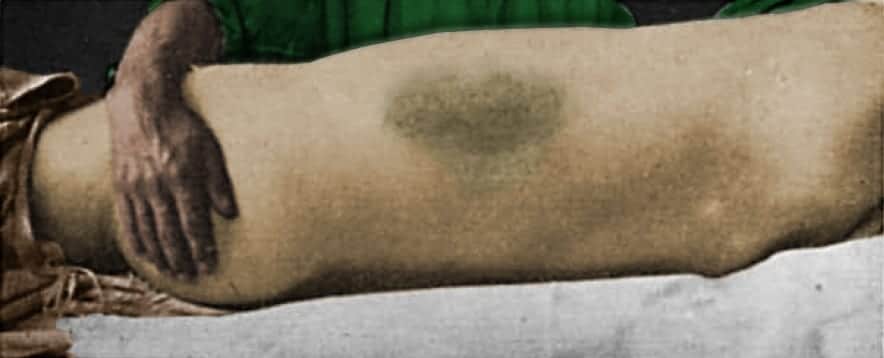George Grey Turner

George Grey Turner (1877-1951) was an English surgeon.
Eponymously affiliated with Grey Turner sign after his description of flank ecchymosis in 1919. Global traveler had audiences with the Pope, Mussolini, the King of Italy and King Alfonso of Spain.
Involved in the embryonic stages of cancer research, he anticipated the development of chemotherapy and published a hopeful tome entitled – Some Encouragements in Cancer Surgery in 1925.
Grey Turner firmly believed that “We shall never overcome cancer by surgery: it will be something we will inject…”
Biography
- Born on September 8, 1877
- Medical training at Rutherford Technical College in Newcastle upon Tyne and the University of Durham College of Medicine
- 1899 – Royal Victoria Infirmary, under Rutherford Morrison
- 1903 – Fellowship from the Royal College of Surgeons
- WWI – Served with the Royal Army Medical Corps
- 1927 – Professor of Surgery in the University of Durham
- 1934 – President of the Medical Society of London
- Died on August 24, 1951
Medical Eponyms
Grey Turner sign (1919)
Atraumatic abdominal ecchymosis, in particular – bruising of the flanks
1920 – George Grey Turner published a paper on ‘Local discoloration of the abdominal wall as a sign of acute pancreatitis‘ citing two cases of acute pancreatitis with fat necrosis and retroperitoneal haemorrhage, the Grey Turner sign
The first case from 1912 concerned a 54 year old female with three days of abdominal pain presenting with an area of discoloration (a bluish colour), about 6 inches in diameter involving the abdominal wall surrounding the umbilicus.
…the patient suffered from acute pancreatitis, with much effusion into the peritoneal cavity. She lived nine days after operation, and the post-mortem examination disclosed a sloughing pancreas with much fat necrosis
Grey Turner 1920
The second case from 1917 promoted the publication. “In a cursory examination of the voluminous literature on pancreatitis I have not observed any mention of this sign“
The tenderness over the gall-bladder region was very marked, and I now noticed two large discoloured areas in the loins. They were about the size of the palm of the hand, slightly raised above the surface, and of a dirty-greenish colour.
Grey Turner 1920

Transhiatul oesophagectomy (1933)
Grey Turner performed the first successful transhiatal oesophagectomy on August 28th 1933. Through a high median abdominal incision, the distal part of the oesophagus was mobilized by sharp and blunt
finger dissection. The proximal esophagus was dissected free via a cervical incision and transected distal to the tumor. The oesophagus with the tumour was brought out via the cervical incision.
Two months after the oesophagectomy, gastrointestinal continuity was restored by a conduit constructed with an ante-thoracic skin flap and anastomosed to the jejunum in the neck
On the 206th day after the excision of the oesophagus the patient ate a meal consisting of three slices of bread and butter with a poached egg, half a pint of tea, and two pears. This he enjoyed thoroughly and in his own words ” he was able to swallow it just as well as ordinary.”
Major Publications
- Grey Turner G. Local discoloration of the abdominal wall as a sign of acute pancreatitis. Br J Surg. 1920;7:394-395
- Turner GG. Excision of the thoracic oesophagus for carcinoma: with construction of an extra-thoracic gullet. Lancet. 1933; 222(5754):1315-1316
- Grey Turner G. Modern Operative Surgery. 1943
- Grey Turner G. Injuries and diseases of the oesophagus In: George Haliburton Hume Memorial Lectures. Cassell 1946
References
Biography
- Willan RJ. George Grey Turner. Ann R Coll Surg Engl. 1951; 9(4): 274–276
- Guthrie D. George Grey Turner 1877-1951. Trans Meet Am Surg Assoc Am Surg Assoc. 1952; 70: 433-435
- Biography: George Grey Turner (1877–1951). Br J Surg. 1965; 52: 641-646
- Welbourn RB. George Grey Turner, 1877-1951. Centenary Celebration at the Royal Postgraduate Medical School. Ann R Coll Surg Engl. 1978; 60(4): 298
- White, H. An outstanding ISS/SIC surgeon: George Grey Turner. World J Surg. 2003 May;27(5):511-3.
- Biography: Turner, George Grey. Plarr’s Lives of the Fellows Online. Royal College of Surgeons of England.
- Bibliography. Turner, George Grey. WorldCat Identities
Eponymous terms
- Meyers MA, Feldberg MA, Oliphant M. Grey Turner’s sign and Cullen’s sign in acute pancreatitis. Gastrointest Radiol. 1989 Winter;14(1):31-7.
- Epperla N, Mazza JJ, Yale SH. A Review of Clinical Signs Related to Ecchymosis. WMJ. 2015; 114(2): 61-65.
- McKennedy C. Grey Turner sign: Eponym A Day. Instagram
- Cadogan M. Non-traumatic abdominal ecchymosis. 2020
Eponym
the person behind the name
